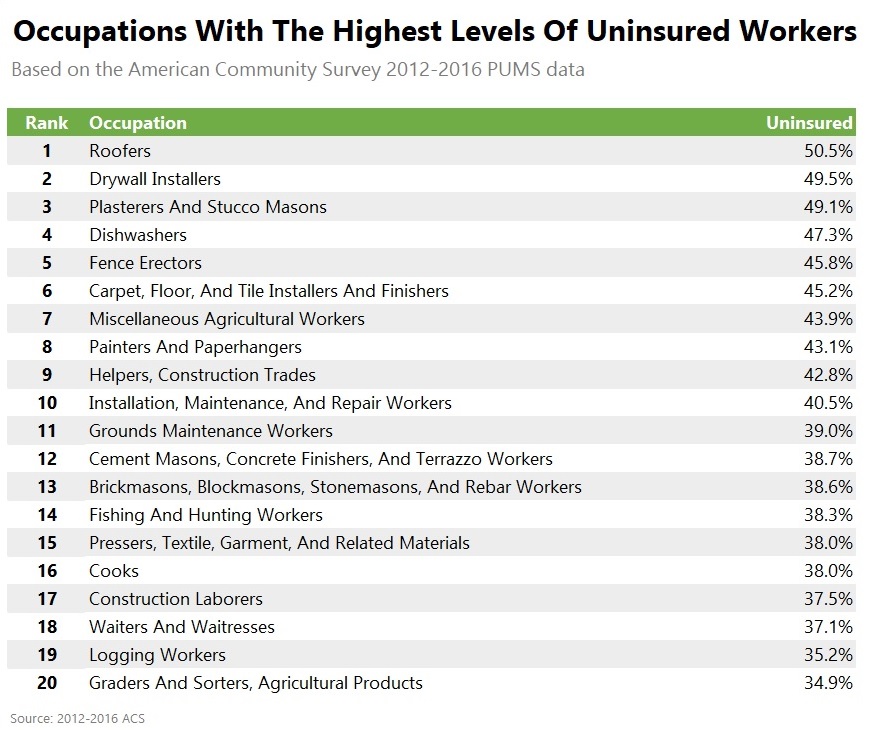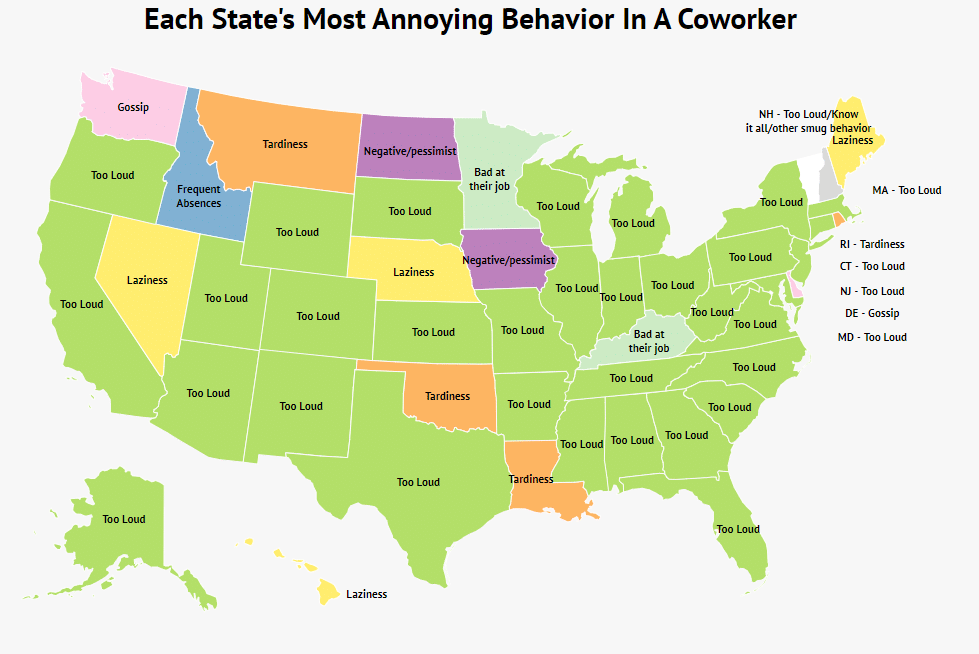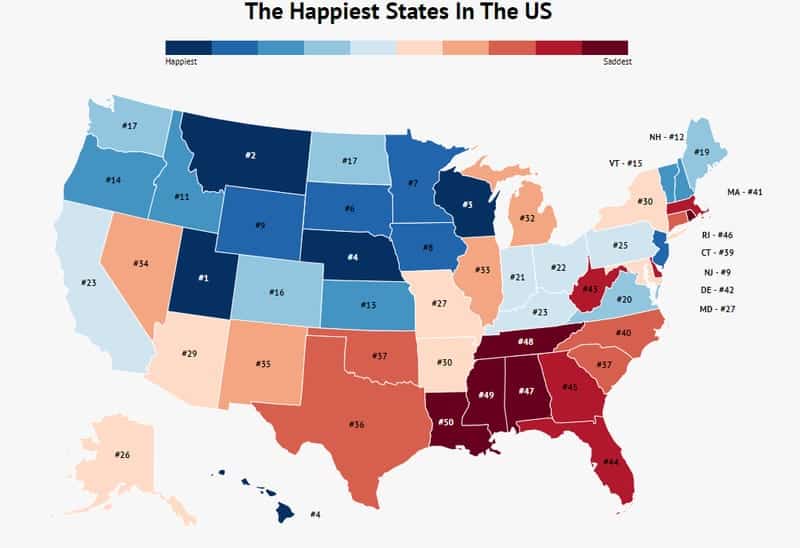Find a Job You Really Want In
Feeling stressed?
You’re not alone. A recent Gallup poll found that a staggering 55% of Americans experience severe stress throughout the workday. Stress leads to illness, increased work absenteeism, and losses in productivity.
It’s no surprise. Across the country people have a lot to be anxious about. From big bills and small bank accounts, to long hours and long commutes, life can get pretty stressful. However, just like your major and your career choices, where you live and work has consequences for your state of mind.
To determine the cities where Americans are dealing with the most stress, Zippia examined nearly 200 cities across 5 of the most stress inducing areas. The results? It turns out stress isn’t evenly spread throughout the country. Some cities are near to boiling over with stress, while others are as cool as a cucumber. Keep reading to see where you city landed.
Main Findings

Most And Least Stressed Cities
| Rank | City | Commute Time | Unemployment (%) | Hours Works | % Uninsured | Income To Housing Costs (Less Is Worse) |
|---|---|---|---|---|---|---|
| 1 | Honolulu, HI | 29 | 4 | 39 | 29 | 12.51% |
| 2 | Warren, MI | 26 | 5 | 39 | 20 | 17.37% |
| 3 | St. Petersburg, FL | 35 | 7 | 37 | 28 | 15.20% |
| 4 | Clarksville, TN | 37 | 4 | 39 | 15 | 18.21% |
| 5 | Frisco, TX | 41 | 4 | 39 | 11 | 10.65% |
| 6 | Fremont, CA | 35 | 5 | 38 | 13 | 22.39% |
| 7 | Naperville, IL | 31 | 4 | 37 | 17 | 9.74% |
| 8 | Miami, FL | 29 | 4 | 38 | 23 | 21.96% |
| 9 | Elk Grove, CA | 30 | 5 | 40 | 4 | 14.53% |
| 10 | New Orleans, LA | 26 | 5 | 40 | 32 | 45.43% |
| 11 | Sioux Falls, SD | 27 | 5 | 39 | 13 | 21.15% |
| 12 | Des Moines, IA | 35 | 6 | 37 | 16 | 22.13% |
| 13 | Spokane, WA | 26 | 4 | 38 | 25 | 15.96% |
| 14 | Richmond, VA | 30 | 5 | 36 | 18 | 15.00% |
| 15 | Overland Park, KS | 27 | 4 | 40 | 29 | 31.70% |
| 16 | Chula Vista, CA | 30 | 4 | 38 | 12 | 11.66% |
| 17 | Omaha, NE | 25 | 4 | 38 | 20 | 22.27% |
| 18 | Boise, ID | 24 | 4 | 39 | 16 | 23.42% |
| 18 | Greensboro, NC | 29 | 6 | 37 | 22 | 26.75% |
| 20 | Little Rock, AR | 28 | 6 | 36 | 19 | 19.11% |
| 21 | Fort Lauderdale, Fl | 34 | 4 | 38 | 11 | 15.90% |
| 22 | West Valley, UT | 24 | 5 | 38 | 14 | 18.02% |
| 23 | Aurora, CO | 32 | 4 | 38 | 10 | 10.90% |
| 24 | Salinas, CA | 33 | 4 | 37 | 14 | 20.13% |
| 25 | Plano, TX | 27 | 3 | 40 | 29 | 29.57% |
| 26 | Lancaster, CA | 31 | 2 | 41 | 13 | 17.37% |
| 27 | Stockton, CA | 31 | 5 | 37 | 14 | 17.69% |
| 27 | Irving, TX | 30 | 6 | 38 | 12 | 20.69% |
| 29 | Fort Collins, CO | 29 | 4 | 39 | 27 | 40.35% |
| 30 | Gilbert, AZ | 33 | 6 | 38 | 13 | 27.90% |
| 31 | Louisville, KY | 21 | 4 | 40 | 17 | 24.65% |
| 32 | Huntington Beach, CA | 25 | 4 | 39 | 16 | 30.37% |
| 33 | Lakewood, CO | 25 | 4 | 38 | 17 | 23.30% |
| 34 | Arlington, VA | 33 | 3 | 40 | 5 | 10.36% |
| 35 | Cincinnati, Ohio | 31 | 3 | 39 | 26 | 43.43% |
| 36 | Aurora, IL | 28 | 3 | 37 | 17 | 12.89% |
| 36 | Tuscon, AZ | 42 | 5 | 37 | 12 | 23.72% |
| 38 | Cary, NC | 25 | 4 | 38 | 18 | 25.19% |
| 39 | Glendale, CA | 29 | 5 | 37 | 10 | 16.42% |
| 40 | Jackson, MI | 28 | 9 | 36 | 20 | 26.25% |
| 41 | Savannah, GA | 23 | 3 | 39 | 19 | 15.50% |
| 42 | San Jose, CA | 30 | 5 | 38 | 4 | 13.52% |
| 42 | Fullerton, CA | 29 | 3 | 39 | 15 | 24.15% |
| 44 | Oakland, CA | 28 | 4 | 37 | 11 | 8.63% |
| 45 | Laredo, TX | 29 | 3 | 38 | 15 | 25.01% |
| 46 | Kansas, MO | 22 | 5 | 38 | 20 | 21.34% |
| 47 | Reno, NV | 30 | 5 | 36 | 14 | 18.95% |
| 48 | Nashville-Davidson, TN | 27 | 3 | 37 | 32 | 16.28% |
| 49 | Virginia Beach, VA | 27 | 3 | 40 | 22 | 38.40% |
| 50 | Birmingham, Al | 21 | 5 | 41 | 17 | 41.50% |
| 51 | Newark, NJ | 28 | 3 | 39 | 11 | 10.71% |
| 51 | Norfolk, VA | 29 | 3 | 38 | 13 | 14.92% |
| 53 | Denver, CO | 25 | 3 | 37 | 24 | 13.57% |
| 54 | Wichita, KS | 27 | 4 | 38 | 18 | 27.74% |
| 55 | Indianapolis, IN | 20 | 5 | 39 | 19 | 32.03% |
| 56 | Fort Wayne, IN | 28 | 6 | 38 | 10 | 21.59% |
| 57 | Hayward, CA | 31 | 5 | 38 | 9 | 31.23% |
| 58 | Alburquerque, NM | 35 | 4 | 38 | 9 | 18.95% |
| 59 | Peoria, AZ | 24 | 4 | 39 | 15 | 32.68% |
| 60 | Tulsa, OK | 27 | 3 | 38 | 18 | 26.61% |
| 60 | New York, NY | 28 | 3 | 39 | 23 | 43.13% |
| 62 | Tallahassee, FL | 27 | 3 | 37 | 19 | 14.73% |
| 63 | Olathe, KS | 24 | 4 | 38 | 11 | 13.26% |
| 63 | Bellevue, WA | 24 | 2 | 39 | 16 | 21.60% |
| 65 | Springfield, MA | 30 | 4 | 36 | 9 | 11.72% |
| 66 | Vancouver, WA | 27 | 3 | 39 | 22 | 37.12% |
| 67 | Santa Clarita, CA | 25 | 2 | 39 | 13 | 17.85% |
| 67 | Yonkers, NY | 24 | 3 | 40 | 25 | 37.54% |
| 69 | Fontana, CA | 24 | 5 | 38 | 15 | 31.17% |
| 70 | Baltimore, MD | 31 | 3 | 39 | 10 | 25.24% |
| 70 | Paterson, NJ | 19 | 4 | 39 | 34 | 38.16% |
| 72 | Orlando, Fl | 19 | 5 | 40 | 16 | 33.97% |
| 73 | Grand Rapids, MI | 23 | 4 | 39 | 15 | 26.87% |
| 74 | Minneapolis, MN | 28 | 3 | 38 | 18 | 31.66% |
| 74 | Jersey City, NJ | 21 | 5 | 39 | 19 | 38.76% |
| 76 | Boston, MA | 36 | 3 | 37 | 11 | 17.80% |
| 77 | Salt Lake City, UT | 21 | 5 | 37 | 17 | 20.44% |
| 77 | Santa Ana, CA | 29 | 4 | 38 | 15 | 39.11% |
| 79 | Knoxville, TN | 24 | 4 | 41 | 13 | 35.65% |
| 80 | Raleigh, NC | 22 | 5 | 38 | 11 | 25.88% |
| 81 | Henderson, NV | 24 | 3 | 39 | 16 | 25.81% |
| 82 | Brownsville, TX | 20 | 6 | 37 | 26 | 27.12% |
| 83 | Chandler, AZ | 22 | 4 | 38 | 27 | 36.85% |
| 84 | Corpus Christi, TX | 29 | 2 | 42 | 7 | 17.53% |
| 85 | Detroit, MI | 30 | 2 | 39 | 12 | 26.28% |
| 86 | Sunnyvale, CA | 24 | 3 | 39 | 22 | 37.27% |
| 87 | Huntsville, AL | 22 | 3 | 38 | 15 | 23.11% |
| 88 | Philadelphia, PA | 32 | 3 | 38 | 7 | 21.69% |
| 89 | Hialeah, Fl | 24 | 3 | 39 | 5 | 11.85% |
| 89 | Arlington, TX | 28 | 3 | 38 | 15 | 26.47% |
| 91 | Dallas, TX | 32 | 4 | 37 | 6 | 18.23% |
| 91 | Sacramento, CA | 21 | 6 | 38 | 19 | 39.63% |
| 91 | Toledo, OH | 21 | 5 | 38 | 27 | 47.57% |
| 94 | Anaheim, CA | 22 | 3 | 39 | 16 | 26.86% |
| 95 | Fort Worth, TX | 35 | 2 | 38 | 2 | 14.75% |
| 95 | Alexandria, VA | 21 | 6 | 37 | 14 | 21.01% |
| 97 | McKinney, TX | 30 | 3 | 38 | 7 | 13.14% |
| 98 | Thornton, CO | 21 | 5 | 38 | 19 | 40.32% |
| 99 | Jacksonville, Fl | 20 | 4 | 38 | 18 | 30.69% |
| 100 | Seattle, WA | 25 | 5 | 37 | 9 | 18.65% |
| 101 | Scottsdale, AZ | 27 | 3 | 39 | 5 | 14.14% |
| 101 | Enterprise, NV | 23 | 4 | 38 | 14 | 35.92% |
| 103 | Lincoln, NE | 18 | 3 | 40 | 14 | 27.04% |
| 104 | Long Beach, CA | 29 | 2 | 38 | 8 | 12.54% |
| 104 | Grand Prairie, TX | 18 | 4 | 39 | 22 | 34.44% |
| 106 | Paradise, NV | 29 | 3 | 38 | 11 | 23.41% |
| 107 | Mobile, Al | 20 | 7 | 38 | 20 | 41.37% |
| 108 | Macon, GA | 24 | 3 | 36 | 25 | 16.54% |
| 108 | Corona, CA | 24 | 3 | 38 | 17 | 26.08% |
| 110 | Oklahoma, OK | 21 | 5 | 37 | 16 | 24.68% |
| 110 | Boston, MA | 29 | 2 | 40 | 12 | 31.98% |
| 112 | Milwaukee, WI | 31 | 4 | 38 | 11 | 39.16% |
| 113 | Columbus, GA | 23 | 5 | 36 | 13 | 21.95% |
| 113 | Columbus, OH | 25 | 3 | 38 | 11 | 22.61% |
| 115 | Providence, RI | 21 | 2 | 39 | 17 | 25.18% |
| 116 | Los Angeles, CA | 19 | 4 | 38 | 15 | 26.44% |
| 117 | El Paso, TX | 28 | 3 | 37 | 12 | 12.62% |
| 118 | Akron, OH | 33 | 3 | 37 | 8 | 15.41% |
| 118 | Masa, Arizona | 23 | 3 | 39 | 15 | 29.42% |
| 120 | Mesquite, TX | 26 | 2 | 40 | 13 | 31.62% |
| 121 | Shreveport, LA | 21 | 5 | 38 | 19 | 34.28% |
| 122 | Killeen, TX | 22 | 3 | 39 | 9 | 23.83% |
| 123 | Pembroke Pines, FL | 21 | 3 | 39 | 20 | 35.16% |
| 123 | Cleveland, OH | 25 | 5 | 39 | 10 | 42.45% |
| 125 | Atlanta, GA | 28 | 3 | 39 | 8 | 29.37% |
| 126 | San Bernardino, CA | 24 | 2 | 39 | 6 | 15.24% |
| 127 | Hollywood, FL | 19 | 3 | 40 | 24 | 41.82% |
| 128 | Oceanside, CA | 22 | 3 | 38 | 11 | 24.66% |
| 128 | Rancho Cucamonga, CA | 26 | 9 | 36 | 16 | 64.51% |
| 130 | McAllen, TX | 28 | 2 | 38 | 6 | 12.46% |
| 130 | San Francisco, CA | 22 | 5 | 36 | 16 | 28.41% |
| 132 | Joliet, IL | 23 | 3 | 40 | 11 | 27.05% |
| 132 | Buffalo, NY | 22 | 3 | 38 | 23 | 31.68% |
| 134 | Santa Rosa, CA | 21 | 3 | 39 | 15 | 35.29% |
| 135 | Anchorage, AK | 26 | 3 | 37 | 9 | 17.14% |
| 135 | Lubbock, TX | 22 | 3 | 38 | 17 | 33.35% |
| 137 | Moreno Valley, CA | 19 | 4 | 38 | 13 | 18.32% |
| 137 | Metairie, LA | 23 | 3 | 39 | 14 | 26.99% |
| 139 | Modesto, CA | 26 | 3 | 39 | 10 | 28.54% |
| 140 | Springfield, MO | 26 | 2 | 38 | 11 | 19.23% |
| 140 | Kansas City, KS | 31 | 3 | 37 | 3 | 24.03% |
| 142 | Winston-Salem, NC | 30 | 2 | 41 | 6 | 34.55% |
| 143 | Las Vegas, NV | 25 | 3 | 38 | 4 | 12.67% |
| 144 | Chandler, AZ | 19 | 4 | 38 | 15 | 27.46% |
| 145 | Amarillo, TX | 22 | 2 | 40 | 8 | 18.56% |
| 145 | Fresno, CA | 34 | 3 | 38 | 3 | 28.77% |
| 147 | Riverside, CA | 21 | 3 | 38 | 36 | 35.27% |
| 148 | Tempe, AZ | 23 | 3 | 37 | 11 | 14.56% |
| 148 | Bridgeport, CT | 22 | 3 | 39 | 9 | 26.79% |
| 148 | Palmdale, CA | 19 | 4 | 38 | 16 | 38.40% |
| 151 | Irvine, CA | 24 | 8 | 37 | 13 | 42.35% |
| 152 | Escondido, CA | 22 | 6 | 37 | 10 | 29.85% |
| 153 | Miramar, FL | 22 | 5 | 37 | 14 | 33.93% |
| 154 | San Deigo, CA | 23 | 2 | 38 | 4 | 10.56% |
| 155 | Tacoma, WA | 27 | 3 | 39 | 6 | 29.75% |
| 156 | Port St. Lucie, FL | 21 | 4 | 37 | 13 | 26.49% |
| 157 | Tampa, FL | 20 | 3 | 38 | 43 | 41.67% |
| 158 | Glendale, AZ | 19 | 3 | 38 | 15 | 19.49% |
| 158 | Garden Grove, CA | 24 | 2 | 39 | 8 | 28.32% |
| 160 | Portland, OR | 21 | 4 | 38 | 14 | 30.54% |
| 161 | Rockford, Il | 22 | 3 | 37 | 11 | 24.02% |
| 162 | Chesapeake, VA | 22 | 4 | 38 | 8 | 33.69% |
| 162 | San Antonio, TX | 17 | 2 | 40 | 21 | 41.31% |
| 164 | Colorado Springs, CO | 18 | 3 | 38 | 16 | 39.55% |
| 165 | St. Paul, MN | 18 | 5 | 35 | 11 | 22.68% |
| 166 | Spring Valley, NV | 23 | 4 | 37 | 8 | 25.01% |
| 167 | Eugene, OR | 24 | 4 | 36 | 4 | 21.03% |
| 168 | Baton Rogue, Louisiana | 21 | 5 | 36 | 6 | 24.10% |
| 168 | Torrance, CA | 21 | 4 | 38 | 11 | 36.09% |
| 170 | Memphis, TN | 21 | 7 | 37 | 11 | 48.01% |
| 171 | Fayettteville, NC | 19 | 3 | 37 | 15 | 30.57% |
| 172 | Pomona, CA | 21 | 3 | 36 | 12 | 21.19% |
| 172 | Montgomery, AL | 22 | 2 | 39 | 7 | 29.93% |
| 174 | Pasadena, TX | 21 | 5 | 37 | 11 | 46.11% |
| 175 | Chicago, IL | 20 | 3 | 37 | 15 | 29.27% |
| 176 | Austin, TX | 20 | 5 | 37 | 11 | 46.43% |
| 177 | Chattanoog, TN | 18 | 2 | 39 | 12 | 30.69% |
| 178 | Sunrise Manor, NV | 18 | 4 | 34 | 9 | 18.03% |
| 179 | Salem, OR | 20 | 4 | 38 | 13 | 43.42% |
| 180 | Hayward, CA | 24 | 4 | 36 | 8 | 28.03% |
| 181 | St. Louis, MO | 20 | 4 | 36 | 7 | 18.38% |
| 182 | Bakersfield, CA | 19 | 4 | 37 | 12 | 35.82% |
| 183 | Durham, NC | 18 | 3 | 37 | 13 | 24.61% |
| 184 | Cape Coral, FL | 18 | 3 | 38 | 13 | 37.58% |
| 185 | Lexington-Fayette, KY | 20 | 7 | 36 | 9 | 40.73% |
| 186 | Charlotte, NC | 20 | 3 | 37 | 9 | 30.39% |
| 186 | Augusta, GA | 17 | 3 | 36 | 17 | 30.97% |
| 186 | Oxnard, CA | 24 | 3 | 37 | 8 | 39.41% |
| 189 | Washington DC | 19 | 4 | 38 | 9 | 41.08% |
| 190 | Pasadena, CA | 16 | 2 | 38 | 17 | 37.03% |
| 191 | Phoenix, AZ | 20 | 2 | 39 | 6 | 31.64% |
| 192 | Rochester, NY | 21 | 2 | 39 | 9 | 38.09% |
| 193 | Madison, WI | 20 | 3 | 37 | 8 | 27.44% |
| 194 | Pittsburgh, PA | 16 | 2 | 39 | 9 | 33.70% |
| 195 | North Las Vegas, Nevada | 21 | 4 | 36 | 8 | 43.30% |
| 196 | Ontario, CA | 18 | 2 | 37 | 10 | 34.26% |
| 197 | Newport, VA | 19 | 2 | 36 | 5 | 26.87% |

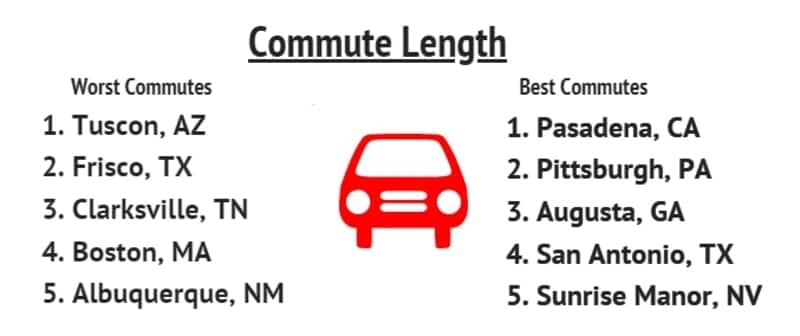

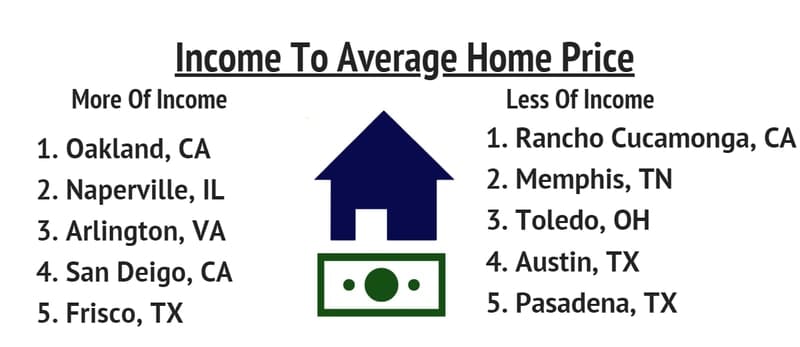
Methodology – HOW WE DETERMINED The Most (And Least) Stressful Cities
Each city was ranked 1-to-197 in five categories:
- Commute Time
- Hours Worked
- Unemployment
- % Of Residents Uninsured
- Income To Housing Costs
All data came from the most recent 5 year Census American Community Survey.
Stress is a complicated, nuanced emotion that can be difficult to quantify. We elected to examine factors that contribute to quality of life and peace of mind.
The first two factors, average commute time and average hours worked, directly impact work-life balance. The more time you spend working (or driving to work) the less time you have to spend with family and friends or on hobbies you enjoy. No matter how much you love your job, having the chance to unwind and step back from the stresses of the day is important for mental health. The longer the commute and more hours worked, the more stressed a city was.
Thirdly, we examined unemployment. The only thing worse than a job you hate might be not being able to find a job at all. Free time is nice, but so is food and shelter. The higher the rate of unemployment, the more stressed a city was.
After that we looked at percent of resident uninsured. Access to healthcare provides peace of mind and can lower healthcare related stress. The less insured a population was, the more stressed a city.
Finally, we delved into income to housing costs. Finances, in addition to job and health, are one of the biggest stressors in modern society. We ranked each city on how much a median salary cost is compared to median home cost. While not everyone owns a home, it is a staple of the American dream and being able to afford a home is an important marker of financial security. The closer the average annual salary to average house cost, the least stress. This is one factor where the 5 year ACS data slightly skewed some fast growing cities, for example booming Austin’s value won’t go far towards purchasing a house in 2020.
Summary On The Most (And Least) Stressful Cities
Stress can be highly situational. While we examined key factors that can contribute to stress (work-life balance, finances etc), your own life might have different stressors or be pretty stress-free. So, if you’re sitting in Honolulu or Warren, Michigan and feeling pretty good, this study might have you scratching your head. Congrats, your neighbors might not be coping as well.
Similarly, if you’re in one of the least stressed cities and feel extremely stressed- that is also possible.
The biggest thing to take away from this study? Some cities have deficiencies that can make life more stressful. Since stress has negative mental and physical consequences, that means residents in these states might need to focus more on stress reduction. So, next time you’re stuck in traffic on the way to work, maybe take a deep breath and know it’s not all your fault– it’s all about location, location, location.
Need some specific data or stats for your coverage? Email kmorris@zippia.com with your requests.

